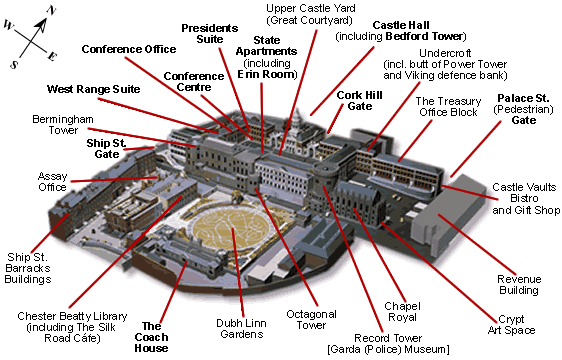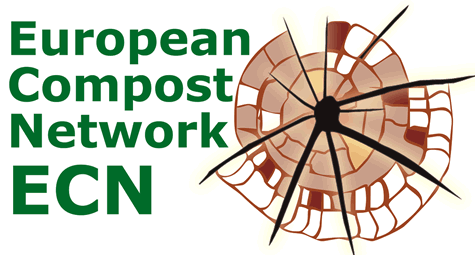
![]()


CONFERENCE VENUE
LOCATION
Dublin Castle is situated in the very heart of Dublin City, on the south side of the River Liffey,
off Dame
Street, en route from Trinity College to Christchurch Cathedral.
There are a number of public car parks nearby. The nearest is that of Jury's
Inn Christchurch,
which is located in Werburg Street: Tel. 00353 1 454 0000,
Fax 00353 1 454 0012
Dublin Bus routes nos. 77, 77A, 56A and 49 from Eden Quay and no. 123 from
O'Connell Street
stop at Palace Street Gate, see Dublin Bus.
CRE / ECN Conference will be in the 'Conference Centre'
Delegate will access the Castle by the CORK HILL GATE
www.dublincastle.ie

HISTORY OF DUBLIN CASTLE
Dublin Castle is situated in the very heart of historic Dublin. In fact the city gets its name from the Dubh Linn or Black Pool (dubh = black), on the site of the present Castle Gardens and Coach House.
The Castle stands on the high ridge, the highest ground in the locality, at the junction of the River Liffey and its tributary the (now underground) Poddle, which formed a natural boundary on two sides. It is very probable that the original fortification on this easily defended strategic site was a Gaelic Ringfort, which guarded the harbour, the adjacent Dubhlinn Ecclesiastical Centre and the four long distant roads that converged nearby.
In the 930's, a Danish Viking Fortress stood on this site and part of the town defences is on view at the Undercroft, where the facing stone revetments offered protection against the River Poddle. Their settlement of Dyflinn (a corruption of Dubhlinn) quickly became the main Viking military base and trading centre of slaves and silver, in Ireland. The Norwegian and sometimes Danish rulers had control of the Irish Sea and forayed deep into the centre of Ireland, where monasteries, with their precious ornaments and vessels, were easy targets. Eventually their power was broken, when they and their allies were heavily defeated by an Irish army under the command of King Brian Boru, at the Battle of Clontarft, 1014.
Neither the Irish nor the Vikings could withstand the Norman invasion of 1169. The Vikings were ejected and the Normans became the next occupiers of Dublin. They strengthened and expanded the existing town walls. It is assumed that their first fortification was an earth and wooden, motte and bailey, on the site of present day Dublin Castle. There is archaeological evidence of a wooden and stone castle there in the 1170's.
In August 1204, King John of England commanded the erection of a (larger) strong castle, with strong walls and good ditches, for the defence of the city, administration of justice and safe custody of treasure. It was completed by 1230 and the Great Courtyard (Upper Castle Yard) of today corresponds closely with the fortification.
The Towers of the Castle
The south-east Record Tower is the last intact medieval tower, not only of Dublin Castle but also of Dublin itself. It functioned as a high security prison and held native Irish hostages and priests in Tudor times.
The Octagonal Tower, in the southern curtain wall, replaces an earlier D shaped tower that contained loops for archers to cover attack.
The south-west Bermingham Tower can be viewed at Ship Street Gate. It also functioned as a prison as well as storing administration records. Following an explosion, it was taken down to first floor level and rebuilt in 1777.
The Square Tower abuts the Bermingham Tower, where the city wall crossed the moat. It was reduced in height to form a gunnery platform, the remains of which are still visible. Immediately outside Ship Street Gate is a stretch of medieval town wall, which contains part of the Stanyhurst Tower. The River Poddle provided drinking water for Dublin and now runs underground through the Castle from Ship Street gate to the Chapel Royal and then northwards to the Undercroft.
The remains of the north-west Corke Tower partly support the modern International Conference Centre.
The butt of the north-east (Gun) Powder Tower is visible at the Undercroft and contains part of the 10th Century Viking town defence bank. The medieval city wall joins the Castle at this point and there is a small gateway in the wall which gave access to the moat.
Bedford Tower occupies the site of the original Norman Gate, which was a twin D shaped barbican gate, with portcullis and drawbridge. It functioned as guardhouse and prison block. The River Poddle was diverted to fill the 12.2m x 6.1m dry ditch along the northern curtain wall, which was 3m thick to facilitate sentry patrols.
Many of the Castle's functions adapted and changed over the centuries. It was always the centre of the English colonial administration. It acted as the official residence of successive royal chief representatives, under the interchangeable titles of Justiciar, Chief Lieutenant, Lord Lieutenant or Viceroy and visiting English Kings. Their coats of arms are displayed on the carved oak galleries and stained glass windows of the Chapel Royal. The Castle played host to a subordinate Royal Court. It was the dungeon for state prisoners and the seat of Parliament, which met in the Great Hall (it burnt down in the great fire of 1684 and moved to College Green in 1731). Courts of Law and the Court of Exchequer also met here. It was also the repository of the royal treasury and site of the Royal mint. Army and police barracks, armaments factories and weapons stores were all located within its precincts.
In 1565, thirty years after Henry VIII brought the Reformation to Ireland, the new Lord Deputy Henry Sidney moved his household into Dublin Castle. From then on the Castle became the control centre for the vicious wars and religious persecution against the Irish Chieftains and the 'Old English' Catholics, many of whom were of Norman stock. By the end of Queen Elizabeth's reign, the whole island of Ireland had been conquered and new English landholding, political and social structures imposed.
The Castle had been neglected for nearly two hundred years and had become 'ruinous, foul, filthy and great decayed'. Sidney moved out the Law Courts and set in motion a huge, thirteen year, building programme, which resulted in 'a verie faire house for the Lord Deputie or the Chief Governer to reside in'. By 1570, he had built the new Deputie's House, a Chapel, and Clock Tower, laid out the Castle Gardens and repaired the Castle Ditch (or Moat).
No longer a colonial outpost, the Castle became the seat of English Government and administration for all of Ireland. There was an influx of ambitious, Protestant English officials, lawyers and adventurers, who came to benefit from the spoils of conquest, reformation and the official policy of religious persecution - which was passed by statute of the parliament in Dublin Castle in 1585. The darkest century of all began for the native Irish and 'Old English' Catholics (see chapter 8).
In the disastrous fire of 7th April 1684 much of medieval Dublin Castle, including the old Parliament House, burnt down. Connecting buildings and halls were blown up to prevent the flames reaching the gunpowder store in the Powder Tower and the State Papers in the Bermingham Tower. Following this, King James directed that the old walls and as many walls as required be taken down. Rebuilding works began and more stately accommodation replaced the medieval fortification.
So began the modern era in the Castle's history. Charles Brooking's map of 1728 shows the Castle in transition, with building work well underway. Much of present-day Dublin Castle dates from that Georgian era, including the State Apartments, which were renovated in 1746. Trade and prosperity increased and Dublin 'jumped its walls', expanded rapidly and became the second city of the British Empire.
Following the terror that accompanied the 1798 rebellion, the Irish parliament was extinguished, and its legislative powers transferred to London. The brass chandeliers in the Throne Room, of the Castle, commemorate this event - the Union of Great Britain and Ireland (1800). Dublin Castle's role as policy maker virtually ceased and the post of Viceroy degenerated to that of figurehead. The city lost its economic momentum and unemployment, poverty and population increased significantly.
Viceroy Wellesley moved his household to the new Viceregal Lodge in the Phoenix Park (now the Irish President's official residence), in the 1820's and the Castle was then mainly used by Government Departments, the army and the police. However, he and his successors continued to hold court in Dublin Castle, where there had been a history of lavish entertainment by the Viceregal Court, from the 1670's. Successive Viceroys encouraged the participation of the powerful Protestant, ascendancy class in the Castle social life and it remained the focus of Anglo Irish social life throughout the 18th and 19th Centuries, with its heady mixture of pomp and splendour, extravagance, rituals and pageantry.
The most important social period was the six festive weeks of the Castle's balls, leveés and lavish dinners, which came to a climax on Saint Patrick's Day. The Castle was highly decorated for the duration. All staff were attired in state livery and all guests dressed in richly ornamented clothes and splendid uniforms. Unfortunately, this Viceregal entertainment continued undiminished throughout the Great Famine of 1845-1849 and the lavish life style of the privileged was unaffected by the destitution of two million people outside the gates.
The Easter Rebellion of 1916 marked the beginning of the end of British rule. The first fatality was a policeman named O'Brien, who attempted to shut the Cork Hill Gate on an advancing rebel party. The Guard House (the site of present day Castle Hall reception and dining facilities) was captured, but the advantage wasn't pressed home. The first rebel fatality was Captain Séan Connolly, who shortly before had shot Constable O'Brien. He was shot by army snipers, from the roof of Bedford Tower, as he raised the rebel flag on adjacent City Hall.
James Connolly, one of the two principal rebel leaders, had been crippled in the fighting. Following the general surrender, he was brought to the State Apartments and held for a week at the site of the present James Connolly Room. He was court martialed and removed to Kilmainham Gaol where he was executed by firing squad. The series of executions of rebel leaders, which finished with Connolly's death, caused public anger to change to sympathy for the rebels and their cause. A vigorous guerrilla war, the 'War of Independence', got underway with public support.
On 6th December 1921, the Anglo Irish Treaty was signed by which twenty-six (of the thirty-two) counties of Ireland became the Irish Free State (now a Republic) - so ending seven and a half centuries of English colonial rule. The rebel military commander Michael Collins, arrived in the Upper Yard (the Great Courtyard) of Dublin Castle on 16th January 1922 and received the handover of the Castle, from the last Lord Lieutenant FitzAlan, on behalf of the new Irish Government. Remarkably, FitzAlan's coat of arms occupies the final available space in the Castle's Chapel Royal.
We are fortunate that Dublin Castle survived the subsequent Civil War, the transition to Irish nationhood and fall into disrepair. The site has been occupied over the ages and modified to suit its ever-changing functions. All the historic buildings have been restored and the Castle is now fully integrated into Irish society. It now plays host to European Union Presidencies, Heads of State, and leaders of business, industry and government. It is also a major tourist attraction and citizens of all nations experience the varied facilities and the unique historic layers revealed throughout the complex - from the Medieval Tower to the world treasures of the Chester Beatty Library and from the Viking Defence Bank to the splendid State Apartments.
For Further details on the History of Dublin
Castle see
http://www.dublincastle.ie/history.html

